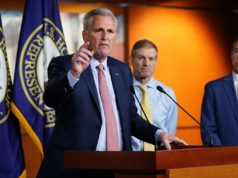
In the wake of the failed effort to reform health care in the United States many are looking quickly to the next items on President Trump’s list of priorities. One topic that both sides of the aisle have discussed as a priority is a large-scale investment into infrastructure to fix our roads, pipes, bridges, transit, and electric grid. While this is often discussed as a way to improve lives and our economy, we believe that—if this is done carefully—it can transform health as well.
We know this because we’ve seen it done across the country and in our cities of Oklahoma City and New York City in our respective red and blue states.
ADVERTISEMENT
There is overwhelming evidence that medical care determines only 20 percent of our health. The vast majority of the other 80 percent—aside from genetics—are factors outside of the health care system such as education, jobs, housing, transportation, and environment. They shape communities and can make us healthier—or sicker. Infrastructure, the catch-all term for the physical, social and digital resources that make communities function, underlie all these determinants of health.
We come at this opportunity from two different perspectives—a republican mayor from Oklahoma, and a former federal official in a democratic administration and the President of The New York Academy of Medicine—but we both see talk of a large-scale investment into infrastructure as a way to transform health, neighborhoods and the economy. Yet, so often, health is not a part of the discussion in state and city government offices across the country.
In Oklahoma City, we’ve taken this to heart. We’ve made a commitment to helping people move around more safely and easily with new sidewalks, bike trails, a modern streetcar and better bus service. We’ve redesigned the built environment to make the city more walkable and we’re creating a city built around people, rather than cars. But it’s not just transportation.
We are also in the midst of developing a 70-acre downtown central park and four new senior wellness centers to address the mental health, socialization and physical wellbeing of an aging Baby Boomer population.
These aren’t just amenities to attract new residents and improve our economy; these are core to our plan to improve health in Oklahoma.
With four-out-of-every-five Americans live in metropolitan areas—a number that continues to climb—this work takes on new urgency. From our experience in two different urban areas, we’d offer four suggestions for how federal investments in infrastructure can be leveraged to have the greatest impact on the health of the nation.
First, like we’ve done in Oklahoma City, we need to invest in the public transportation infrastructure. The benefits are twofold. Research shows that people who use public transit are more physically active, but we also know that this approach to transportation decreases pollution and pedestrian injuries and death from automobiles.
Second, as we’ve seen in cities like Flint, Mich., drinking water—and the infrastructure we use to get it—are essential to our health. We need high-quality water and sewage systems to protect our neighborhoods and our drinking water.
Third, our investments in infrastructure can address disparities in health. This has been a priority of New York’s Mayor Bill de Blasio and it can ensure that low-income communities within cities receive comparable investments in creating streets and bridges that include safe and consistent sidewalks, bike paths, new parks and public spaces. In many communities, this is essential to promoting fitness as well as combating social isolation, which is a cause of poor health among many—especially older adults.
Finally, we need to create regional infrastructure that connects people with affordable, healthy food. This includes investment in facilities that aggregate, process, and store local produce meat, and dairy for distribution to retail and institutional buyers. Investments in public transit can help people access local corner stores, supermarkets and farmers’ markets.
Taken together, a large-scale investment in infrastructure, guided by the question of how we can improve opportunities for health, can be transformative for millions of Americans and cities are willing partners in this effort. Our nation’s mayors know how to get things done on task, on time and on budget. It’s essential that federal infrastructure dollars find their way to cities, where they can have the greatest direct benefit on the health of the majority of our nation’s citizens and our nation’s economic engines.
Regardless of what part of the country we live in, party we identify with, or sector we work in, this is an opportunity to work together to improve the lives of millions of Americans. We urge leaders to seize opportunities and moments where values and interests align so we can make progress to improve our economy and our health.
Mayor Mick Cornett is a republican mayor of Oklahoma City. Jo Ivey Boufford, MD, is the President of the New York Academy of Medicine and former Principal Deputy Assistant Secretary for Health in the U.S. Department of Health and Human Services.
The views expressed by this author are their own and are not the views of The Hill.







